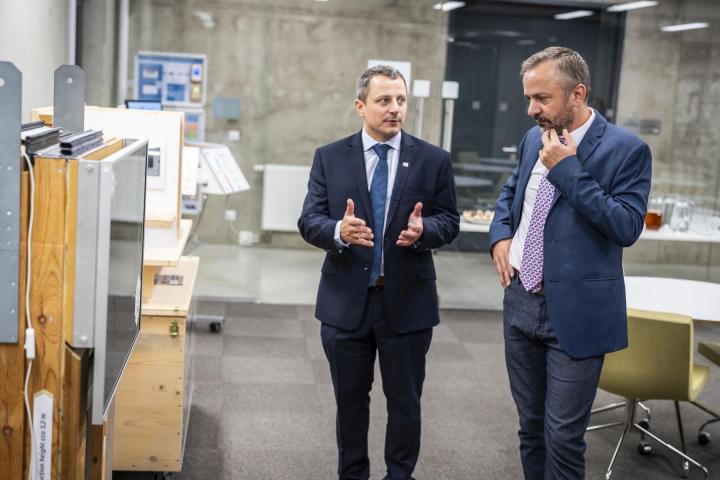
The University Centre for Energy Efficient Buildings (UCEEB) of CTU was established under the Science and Research for Innovation programme. It was opened in mid-May 2014 as an interdisciplinary scientific research institute of CTU. Its aim is to contribute to the reduction of energy consumption and environmental burden in the building sector. Currently, the centre has 18 research teams with nearly 200 experts working on topics such as circular construction, renewable energy, urban ecohydrology and the indoor environment of buildings.
"We wanted to show the Minister that the establishment of UCEEB was a good investment because we are succeeding in bringing the results of our applied research into everyday life. During the visit, we presented him some of the projects we have been working on with partners from industry, and the results have successfully established themselves on the market," said Robert Jára, Director of the CTU UCEEB, adding that he and Minister Ženíšek also discussed the possibility of further development of the thriving science centres and looked together for ways in which the UCEEB could be even more useful to Czech industry and the public sector.
The government has declared many times that a strong research environment is in the common interest of the state, public research organisations and the corporate sector. A joint discussion on how to strengthen research and innovation in the Czech Republic is therefore more than welcome. It is important to succeed in getting inventions to the manufacturer and through him to the user. "I am glad that in the ten years of its existence, UCEEB has achieved a number of successes that show how important innovation is in the field of construction and environmental protection. I am glad to have had the opportunity to see how the Institute's researchers work and how the results of applied research are concretely translated into the real world. These are the successes that applied research brings when it receives sufficient support and is carried out in synergy with industry. In this respect, UCEEB can also be a model for others," said Marek Ženíšek, Minister for Science, Research and Innovation.
During his visit to UCEEB, the minister was also presented with the Centre's rich international cooperation and its contributions to international research in the field of sustainable construction and energy.
"Our intention was also to draw the Minister's attention to the need for a strategic focus on energy and material efficiency, because these are areas that have a strong base and potential for the development of the Czech economy," said Vojtěch Petráček, Rector of CTU. The meeting was attended by Veronika Kramaříková, Vice-Rector for Development and Strategy of CTU, who said: "Every part of CTU can showcase cutting-edge technologies and projects, and UCEEB, which recently celebrated its tenth anniversary, is no exception."
Marek Ženíšek also visited the S.A.W.E.R. system at the UCEEB, which can extract water even from extremely dry desert air. The system was named the best innovation at the 2020 Dubai EXPO, the technology was even the subject of a film called 'Let There Be Water' and the third generation of the system is now in place.
However, other projects were also presented during the ministerial visit to the UCEEB. For example, the MoistureGuard moisture monitoring system for wooden buildings, which can detect problem areas in wooden buildings that are threatened by moisture and inform the user before the structure is degraded. Attention was also drawn to the unique WAVE CHP unit, the lightweight ENVILOP wood-based panel cladding and experimental green roofs. Project.

